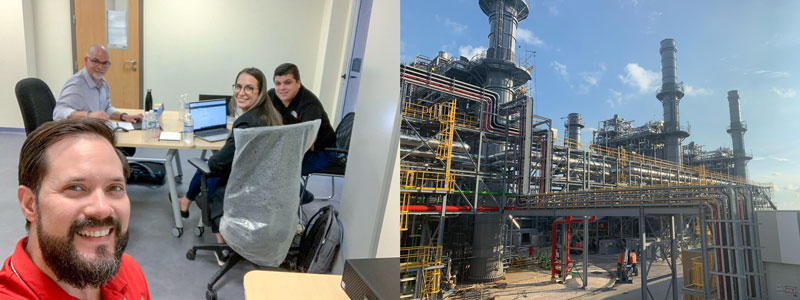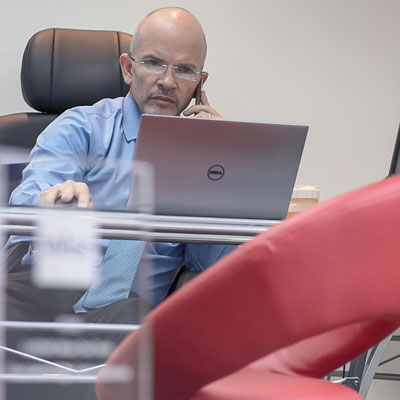Asset Maintenance:
Visual K supporting its customers on the road to reliability
Visual K and HxGN EAM for Asset Maintenance:
In most work environments, it’s not uncommon to find a maintenance department. Whether for facilities, machinery or even computers and office material, enterprises constantly track and look for ways to optimize their assets, so they fail less, last longer and as a general result save, or even generate more money. VisualK has been assisting different industries track their maintenance and identify areas to improve throughout the years. 
VisualK is a company founded in 1998 by Rene Nazario, our CEO. In VisualK, we design solutions based on customer needs and policies. With help from our experienced team, we efficiently implement the solutions, providing support every step of the way: from a design phase, all the way to when the project goes live, and even afterwards. We strive in providing companies all the tools needed for their personnel to be able to use them efficiently and effectively. We also have a partnership with Hexagon, one of the leading enterprise software corporations in the world, which gives us a broad catalog of options to tailor the best solutions for particular requirements. With their software development and our expert team, we have successfully launched and completed projects in over 15 countries for over 200 customers.
When it comes to maintenance in any industry, there are several marked stages towards optimal asset conditions which can be called your “road to reliability”. As companies grow in experience, asset management develops as well. Logic tells you that when a machine is broken you need to fix it. In our experience, when a company is at this maintenance habit, there is always one or more broken machines, and it’s in the most critical moments that another important asset breaks down. This first level of maintenance where technicians are mostly “putting out fires” is called Reactive Maintenance. Many companies have a system of notifying breakdowns, which in EAM is called Work Request. There is no doubt that there will always be unexpected breakdowns, but there are different steps to consider when you want to reduce repairs and corrective work. Did you change the oil? Did you check the fuses? Are all the fluids at the right level? Are measurements like pressure and temperature under specs? These are some of the questions that start to emerge when an enterprise is growing into Preventive Maintenance.
Preventive work can potentially save a lot of money, especially when you follow the User Manuals to review specifications and create a schedule to execute necessary procedures. Maintenance as common as replacing oil in your car every certain amount of time or distance improves your vehicles performance in the long run, extending the life and therefore the value of your asset. Preventive habits prompt users to execute tasks that may appear unaffected from visual assessments, but manufacturers recommend to perform for the benefit of an asset. Companies that have been maintaining their assets for a while, get familiarized with their equipment and can detect trends, based on frequency, run time, cycle count, or other units that are particular to each machine. These trends can then be added to Preventive Maintenance (PM) Schedules, which would be additional to the manufacturer’s recommended procedures, sometimes even adjusting these to a particular environment. Undoubtedly, this would require that technicians running the machines have years of experience, and can almost sense the machines’ pains as their own.
 Next level in maintenance would be condition-based maintenance. Optimum maintenance back in the day would use alarms to let workers know that something is off parameters. For example, if the air is being monitored for CO2 and levels exceed safe parameters, light and noise alarms would be triggered to alert people to get out, and have the maintenance team work on the issue. While these alarms are still important, they could also be used to trigger a Work Order and document the time of the reading, and be able to document any issues that may have caused this. A Standard Work Order can be configured so that a trigger not only creates a work order, but can create a work order that reads something similar to “Atmospheric Gas Level Exceeded, CO2”, including activities, checklists and other protocolary actions related to the situation. Triggers can be configured based on different conditions, and therefore, different combinations can create different reactions within EAM.
Next level in maintenance would be condition-based maintenance. Optimum maintenance back in the day would use alarms to let workers know that something is off parameters. For example, if the air is being monitored for CO2 and levels exceed safe parameters, light and noise alarms would be triggered to alert people to get out, and have the maintenance team work on the issue. While these alarms are still important, they could also be used to trigger a Work Order and document the time of the reading, and be able to document any issues that may have caused this. A Standard Work Order can be configured so that a trigger not only creates a work order, but can create a work order that reads something similar to “Atmospheric Gas Level Exceeded, CO2”, including activities, checklists and other protocolary actions related to the situation. Triggers can be configured based on different conditions, and therefore, different combinations can create different reactions within EAM.
Currently, maintenance is moving to a very broad spectrum that is defined as “Predictive Maintenance”. What this concept means in a very general scenario is that using the data of past measurements, behaviors and conditions, the system is able to “predict” when is a failure bound to happen again. Using Artificial Intelligence (AI), large samples of data (and I mean LARGE!) and the experience of a company to program a certain prediction, you can know when a machine will break, even if these parameters are under manufacturer’s specs. For example, we’ve had a customer that found that their power plant, located in the Caribbean and stationed right next to shore, demanded a less tolerant maintenance, meaning that the environment it was located at, was not necessarily compatible with the conditions that the manufacturer designed their equipment under. Speaking about AI and IoT (Internet of Things) may sound scary based on costs involved and the aggressive cultural adaptation it may require if not implemented correctly. Nevertheless, many industries are more frequently aiming towards predictive habits, because of the long-term benefits that may include monetary savings, prolonged equipment lifecycles and even smoother production runs.
 No matter what stage in the road to reliability your company is at, there are various benefits in using CMMS, ERP’s and other asset tracking software. Enterprises can benefit by increasing reliability of their assets, track asset failures, and monitor costing involved in both maintenance and energy consumption. Likewise, our customers have been using HxGN EAM integrated with many different solutions, which reduces duplicity of data entry and of course, use this data to meet with many different compliance protocols.
No matter what stage in the road to reliability your company is at, there are various benefits in using CMMS, ERP’s and other asset tracking software. Enterprises can benefit by increasing reliability of their assets, track asset failures, and monitor costing involved in both maintenance and energy consumption. Likewise, our customers have been using HxGN EAM integrated with many different solutions, which reduces duplicity of data entry and of course, use this data to meet with many different compliance protocols.
